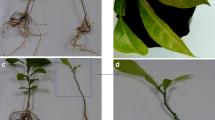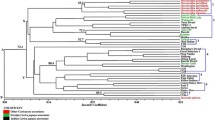Abstract
Cylindrocladium quinqueseptatum has been considered as the most destructive pathogen of Eucalyptus nurseries and plantations in north India. Genetic resistance has not been determined against this disease in Eucalyptus and genetic diversity among the fungal population in northern India is not known. Seventy three isolates from infected leaves and twigs of Eucalyptus were collected from different northern Indian state and analyzed through RAPD-PCR for screening genetic diversity. The UPGMA cluster analysis score of 284 loci permitted identification of 11 population lines and an outlier. This molecular variability prevalent among the north Indian population of the pathogen can used in identifying Cylindrocladium leaf and seedling blight resistant Eucalyptus germplasm.



Similar content being viewed by others
References
Sharma JK, Mohanan C (1982) Cylindrocladium spp associated with various diseases of Eucalyptus in Kerla. Eur J For Pathol 20:15–23. doi:10.1111/j.1439-0329.1982.tb01385
Anahosur KH, Padaganur GM, Hegde RK (1977) Laboratory evaluation of fungicides against Cylindrocladium quinqueseptatum, the causal organism of seedling blight of Eucalyptus hybrid. Pesticides 11:44–45
Seghal HS (1983) Disease problems of Eucalyptus in India. Ind For 12:909–916
Rattan GS, Dhanda RS (1985) Leaf blight and seedling diseases of Eucalyptus caused by Cylindrocladium spp. in Punjab. Ann Biol 1:184–188
Bolland L, Tierney JW, Tierney BJ (1985) Studies on the leaf spot and shoot blight of Eucalyptus caused by Cylindrocladium quinqueseptatum. Eur J For Pathol 15:385–448. doi:10.1111/j.1439-0329.1985.tb00894
Sharma JK, Mohanan C, Florence M (1985) Disease survey in nurseries and plantations of tree species grown in Kerala. Research Report No 37. Kerala Forest Research Institute, Trichi, p 286
Sharma JK, Mohanan C (1991) Pathogenic variation in Cylindrocladium quinqueseptatum causing leaf blight of Eucalyptus. Eur J For Pathol 21:210–217. doi:10.1111/j.1439-0329.1990.tb01269
Wright LP, Wingfield BD, Crows PW, Brenneman T, Wingfield MJ (2006) Isolation and characterization of microsatellite loci in Cylindrocladium parasiticum. Mol Ecol Notes 6:110–112. doi:10.1111/j.1471-8286.2006.01157
Henricot B, Culham A (2002) Cylindrocladium buxicola, a new species affecting Buxus spp., and its phylogenetic status. Mycologia 94(6):980–997
Uchida JY, Aragaki M (1997) Comparative morphology and pathology of Calonectria theae and C. colhounii in Hawaii. Plant Dis 81(3):298–300. doi:abs/10.1094/PDIS.1997.81.3.298
Norman DJ, Henny JR, Yuen J, Reich L (2002) Identification of one-septate Cylindrocladium species affecting Spathiphyllum and Rumohra Adiantiformis (Leather leaf Fern) in Florida. Proc Fla State Hort Soc 115:263–266
Crows PW, Groenewald JZ, Risede JM, Simoneau P, Hyde KD (2006) Calonectria species and their Cylindrocladium anamorphs: species with clavate vesicles. Stud Mycol 55:213–226
Sagai-Maroof MA, Soliman KM, Jorgensen RA, Allard RW (1984) Ribosomal DNA spacer length polymorphism in barley: Mendelian inheritance, chromosomal location and population dynamics. Proc Natl Acad Sci USA 81:8014–8018
Link W, Dixkens C, Singh M, Melchinger AE (1995) Genetic diversity in European and Mediterranean faba bean germ plasm revealed by RAPD markers. Theor Appl Genet 90:27–32
Excoffier L, Smouse P, Quattro J (1992) Analysis of molecular variance inferred from metric distances among DNA haplotypes: application to human mitochondrial restriction data. Genetics 131:479–491
Lanfranco L, Wyss P, Marzachi C, Bontante P (1995) Generation of RAPD PCRprimers for the identification of the isolates of Glomus mosseae, an arbuscular mycorrhiza fungus. Mol Ecol 4:61–68
Hyun JW, Clark CA (1998) Analysis of Fusarium lateritium using RAPD and rDNA RFLP techniques. Mycol Res 102:1259–1264
Jana TK, Sharma TR, Prasad D, Arora DK (2003) Molecular characterization of Macrophomina phaseolina and Fusarium species by single primer RAPD technique. Microbiol Res 158:264–274
Acknowledgments
We thank Indian Council of Forestry Research and Education, Dehradun, Uttarakhand, INDIA for providing funding support. We are also thankful to Dr. A.N. Shukla former head Forest Pathology Division, Forest Research Institute, Dehradun for their help during the course of study.
Author information
Authors and Affiliations
Corresponding author
Rights and permissions
About this article
Cite this article
Mohanty, P.S., Pandey, A., Arya, P. et al. Molecular Variability in North Indian Isolates of Cylindrocladium quinquieseptatum Causing Eucalyptus Leaf and Seedling Blight. Indian J Microbiol 52, 131–136 (2012). https://doi.org/10.1007/s12088-011-0178-2
Received:
Accepted:
Published:
Issue Date:
DOI: https://doi.org/10.1007/s12088-011-0178-2




